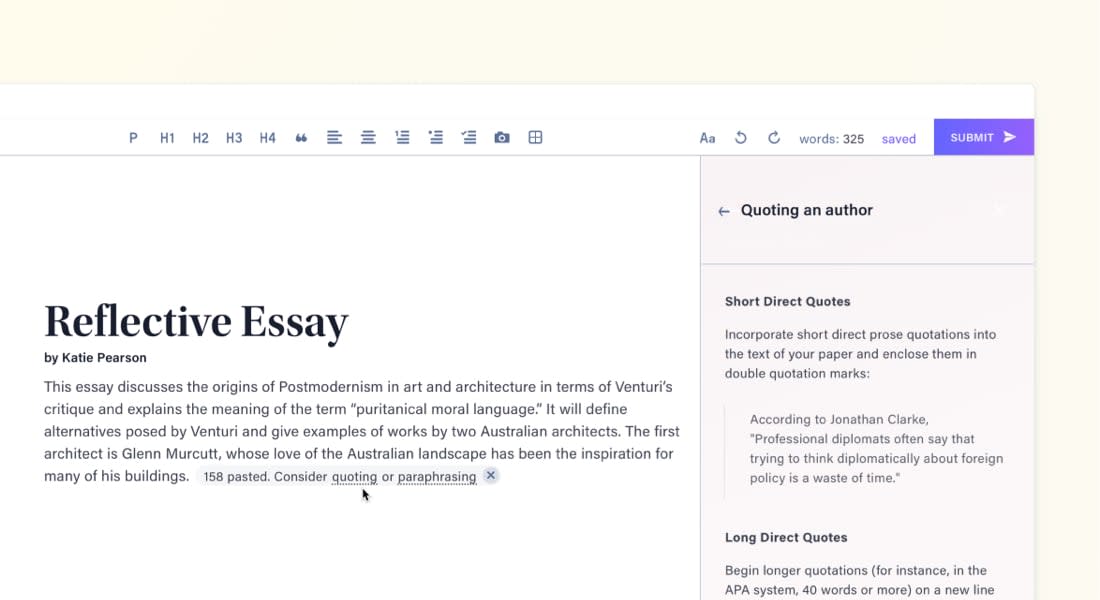News
5 features your assessment platform needs to support learning

Share with colleagues
Download the full Case Study
Take an in-depth look at how educators have used Cadmus to better deliver assessments.
Every day, we see institutions rethinking their long term teaching and learning strategies for a post-pandemic world. Blended and online learning models are here to stay, but many students remain dissatisfied with the lack of contact hours. As a result, universities are scrambling to find ways to increase student engagement and motivation online.
What this student dissatisfaction ultimately speaks to is an underlying desire for more support.
When we look at the way we deliver assessment today, be that through the LMS or other assessment platforms (proctoring, testing tools, etc.), it becomes evident that these solutions were never designed to support students or their learning. These missed opportunities for improving student learning experiences are forcing us to reassess assessment delivery altogether.
By applying an Assessment for Learning mindset to every assessment item (formative or summative), we can identify how technology can enhance student learning. This can help universities identify what features they can expect from assessment platforms and where they are currently falling short.
"What underpins Assessment for Learning is the principle that all assessment, within the overall package, should contribute to helping students to learn and to succeed."
1. Educative nudges
Nudge theory comes from the field of behavioural economics and is centred around the idea of pointing or 'nudging' people towards making desired choices. Just like a helpful suggestion from a teacher in class, nudges are an excellent tool for encouraging students to build essential learning habits.
When nudges are built into the platform where students work, they are consistently provided with timely feedback and reminders. Through repetition, nudges help students develop skills like academic writing, planning, and time management.
In Cadmus, an example of an educative nudge is when students paste external content into their writing space. Student's are reminded to cite the content appropriately or consider paraphrasing. Over time, this behaviour becomes a part of students' natural writing processes allowing for greater self-regulation and authentic writing.
 An example of an educative nudge in Cadmus prompting students to paraphrase or quote
An example of an educative nudge in Cadmus prompting students to paraphrase or quote
2. Integrated learning support
Academic skills and learning support teams will agree — it can be challenging to get students to engage with the wealth of resources that universities produce. This is often because students struggle to identify knowledge gaps, don't know where to seek help, or believe certain services are not for them (De Fazio, Gilding, and Zorzenon, 2001).
With students learning online, we can leverage learning technologies to do a lot of the work to connect students with appropriate resources, where and when they need them. Similar to nudging, making key resources easily and contextually available increases their engagement. After all, if we want students to do something, we need to make it easy.
Consider using an assessment platform that integrates learning support resources and guides into the student working environment. Not only will you see better engagement with resources, but you'll see the quality of student work improve.
3. Feedback and draft management
Students are notorious for never being satisfied with the level of feedback they receive (Corrin and de Barba, 2017). While the features above provide informal feedback to students, it's also important to ensure that the workflows for formal feedback delivery are simple and easy to manage. Providing early feedback is a core principle of Assessment for Learning, and in practice, this can translate to students submitting drafts or work in progress.
Choosing an assessment platform with a built-in draft management workflow can encourage educators to embed more feedback into their assessment designs. Students will be prompted to engage more consistently, while teachers can opt for less time-consuming feedback methods like peer reviews, group reflection, or audio comments.
4. Assessment design guidance
Often, the point at which students lose motivation is early on in their assessment journey. Getting started is usually the hardest part, especially when students don't completely understand what is expected of them. What's worse is that it's easy for students to fall into the trap of not seeking help. One way teachers can help students overcome this initial hurdle is by embedding scaffolds into more extensive assessments. Breaking down larger tasks into manageable stages reduces the barrier to starting and helps students understand the best process for success.
While this can be a time-consuming exercise for academics, assessment platforms like Cadmus have a range of built-in templates across disciplines that make this process a breeze. By letting your assessment platform do the heavy lifting when it comes to assessment redesign, universities will see improvements in student success without overburdening academics.
5. Learning analytics
Another way we can enhance student learning is through responsive teaching. With learning analytics, teachers can understand student engagement in real-time and provide proactive support to students. Assessment platforms that give us more than just clicks and views — how much time students spend working, when they work, note-taking and writing behaviours — provide rich insight into how students learn.
More than this, learning analytics can help build a teaching culture that prioritises regular assessment evaluation. This ensures that assessment practices are continuously evolving to meet diverse student needs.
---
In addition to these learning-centred features, your assessment platform should be underpinned by an exceptional user experience. Like sitting down to work at a tidy desk, the best assessment platforms create space for clarity and thoughtful work. By removing the unnecessary clicks and processes, students can focus on the task at hand, receive targeted support, and put their best work forward.
Take a closer look at Cadmus, the number one assessment for learning platform.
Category
More News
Load more
Company
Cadmus Takes First Place in APUC Framework Agreement
We're excited to announce that we have been awarded the first place in APUC’s Framework Agreement. As a result, higher education institutions across the UK can now procure Cadmus through the University of London (CoSector), streamlining the procurement route.
2025-11-28

AI
Leadership
Student Success
Teaching & Learning
The future of assessment in a shifting higher education landscape: Lessons from the Teaching & Learning Forum
Discover how universities across Australia are reimagining assessment to foster integrity, authenticity, and student success in an AI-driven world.
Cadmus
2025-10-31

Company
Cadmus secures backing to safeguard university learning in the age of AI
Cadmus has secured backing from SEEK Investments and Glitch Capital. With this investment, we’ll continue to advance assessments that safeguard academic integrity, empower educators, and enable meaningful learning for students everywhere.
Cadmus
2025-09-17